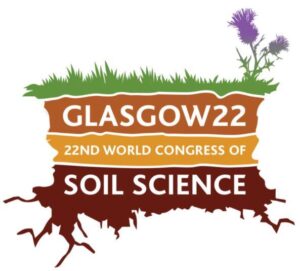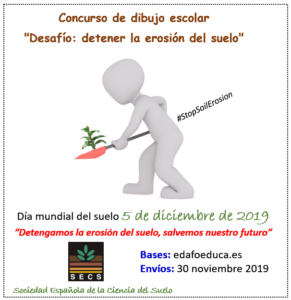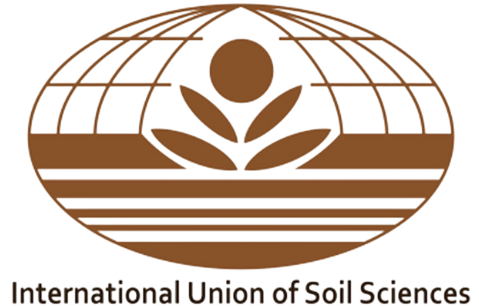IUSS News
1000 days until the World Congress of Soil Science in 2022 (WCSS22)
The logo of the WCSS22 was launched by the British Society of Soil Science on Nov. 4.

What is it? The WCSS is a leading international soil science conference, held every 4 years in different countries and attended by over 3000 soil scientists from around the globe. The next Congress is being organised by the British Society of Soil Science on behalf of the International Union of Soil Sciences. The Congress theme, ‘Soil Science – crossing boundaries, changing society’ will focus on the link between soil and society, with sessions covering soil systems, soil processes, soil management and how we interact with and use soils around the world. There will be opportunities for specialist workshops and discussion sessions across a wide range of soil disciplines. The core programme is supported by tours and a cultural and arts programme for delegates and the wider public to explore our diverse environment and culture.
Where and when is it? The Congress will take place at the award winning and world-class Scottish Event Campus, a riverside venue minutes from central Glasgow in Scotland, UK. The Congress is between 31st July – 5th August 2022.
Who should attend? Research scientists, policy makers, regulators, NGOs and anyone who has an interest in the sustainable use of soils.
Why should I attend? At a time of global concern for our planet and its growing population, managing our soils sustainably has never been as important. 90% of our food comes from soil, as does all of our timber and other fibre. Soil, and the ecosystems it supports, have a huge role in mitigating against climate change, is a vast reservoir of biodiversity, plays a significant role in flood management and contains key evidence of past civilisations. Our understanding of the importance of these functions is developing rapidly and the Congress provides the ideal setting to discover the international state of the art in these critical global issues and an opportunity to connect across all who work with and rely on soils.
Follow us on Twitter: @Soil_Science and @WorldSoils2022
Read more: https://www.soils.org.uk/wcss2022
STOP SOIL DEGRADATION and the IUSS’s educative project to achieve it
4th Soil in the Environment Conference: SITE 2020
The Soil Science Society of Poland invites you to participate in the “4th Soil in the Environment Conference: SITE 2020”, this invitation going especially to Young Researchers involved in soil science. The Conference will be held on 28th June – 1st July 2020 in Toruń, a beautiful medieval city in the north of Poland. https://sites.google.com/view/site-torun-2020
Challenge stop soil erosion
The Spanish Soil Science Society organizes a school contest “Challenge stop soil erosion”. IUSS invites you to send your drawing to edafoeduca@upv.es

Official recognition of Dr. Jaume Porta Casanellas life-long service
The University of Lleida Spain congratulates its Rector (1993-2003) and Professor Emeritus of Edaphology and Agricultural Chemistry: On October 3, the University of Lleida paid tribute to Dr. Jaume Porta Casanellas with the putting up of a plaque in the CCCT library that now bears the name “Jaume Porta Library”. http://www.macs.udl.cat/ca/noticies/Biblioteca-Jaume-Porta/.
Dr. Porta is Former President of the Spanish Society of Soil Science, author of the “Multilingual Dictionary of Soil Science” (Spanish, Catalan, Galician and Portuguese, with equivalences in French and English), founder of the Spanish Journal of Soil Science and author of the most popular Edaphology book in Latin America.
The Latin-American Soil Science Society honours Dr. Jaume Porta Casanellas for his contributions to the teaching of Edaphology in Mexico and throughout Latin-America.
General News
World Soil Day 2019 – Take action!
FAO is pleased to follow up with you about this year’s World Soil Day campaign. Everything is ready to get started! The website has been updated with all brand-new World Soil Day 2019 visual and #StopSoilErosion and #WorldSoilDay are the official hashtags of the campaign. Attached you can find some ideas to “Get involved” with promotional activities around the world, as we are counting on the participation of all FAO offices with all partners to make the campaign a success.
Are you already planning to celebrate World Soil Day – 5 December? Don’t forget to register your event on the global interactive map to be part of the story!
There are a number of campaign materials available posters, infographic, key message cards, a video animation, animated giphies, information on actions in the field and digital and print assets. Most material is available in all UN languages.
Now, TAKE ACTION! Get involved in the Greening the Future: Photo Challenge (All UN languages): Cover the soil with plants and take a #StopSoilErosion pledge by sharing your photos on socials (using the campaign hashtags) and send it to us by 5 December.
Last but not least, remember that the most exciting WSD 2019 celebration can candidate to win USD 15 000 for next King Bhumibol World Soil Day Award!
Many thanks for your support,
The FAO World Soil Day Team
Read more: http://www.fao.org/world-soil-day/en/
Call for Abstracts: “Atmosphere – plant – soil: organic and inorganic carbon in the critical zone”
We invite abstract submissions to a European Geosciences Union (EGU) session exploring organic and inorganic soil carbon across multiple soil interfaces at different spatial and temporal scales in the critical zone.
The EGU General Assembly will bring together soil scientists from around the world and will take place in Vienna between the 3rd and 8th May 2020. Submissions are invited from researchers in all sub-disciplines and all career stages of soil science. The deadline for abstract submissions is the 15th January, 12:00 GMT. In addition, the deadline for financial support applications is the 1st.
Read more: https://tinyurl.com/egucarbon
If you have any questions about the session, contact Dan Evans on d.evans3@lancaster.ac.uk
Listen to the Field, Lab, Earth latest podcast on Soil Health with Dr. Ryan Stewart
Field, Lab, Earth is the podcast all about past and present advances in the fields of agronomic, crop, soil, and environmental sciences. A joint production of the Tri-Societies, the American Society of Agronomy, Crop Science Society of America, and Soil Science Society of America, it features interviews with authors published in our journals, books, and magazines.
Listen to the podcast: https://podcasts.apple.com/us/podcast/field-lab-earth/id1398459753
[From: ASA-CSSA-SSSA Science Policy Report: 30 October 2019]
DIG IT! The Secrets of Soil. SSSA’s Dig It! Exhibit panels are online and available for free download!
The Smithsonian National Museum of Natural History developed the DIG IT! The Secrets of Soil display in 2006, and the Soil Science Society of America was its founding sponsor. Now Dig It! has a new life, in the form of “Dig It! DIY”, an online, downloadable set of infographic panels and an online guide. And, it’s free – in thanks partly to another grant from SSSA via the Agronomic Science Foundation (ASF). You can even make a public display at a library, or other public space!
Read more: https://www.soils.org/discover-soils/dig-it
[From: ASA-CSSA-SSSA Science Policy Report: 27 November 2019]
The Forensic Science Toolbox: Examining Changes in Soil Biodiversity
Dead animals, or carrion, are an undeniable part of every ecosystem. Carcasses are a source of high-quality food for scavengers and insects, and as they decompose, they create local patches of nutrient–rich “hotspots” within the soil that are areas of increased microbial activity. … Vertebrate decomposition research, or taphonomy, also has an important place in the medico-legal field of forensic science. In forensic taphonomy, the focus is on documenting the manner and progression of human decomposition, usually with the specific intent of estimating time since death, or the post-mortem interval (PMI).
[From: GSBI Newsletter – November 2019 ]
Soil Organic Matter (SOM) fractions for 186 LUCAS-2009 soil samples (grassland, forest)
Land management for C sequestration is most often informed by bulk soil C inventories, without considering the form in which C is stored, its capacity, persistency and N demand. Recent frameworks suggest that soil C accrual, its persistence and response to N availability can be better described if SOM is broadly divided into a Particulate Organic Matter (POM) and a Mineral Associated Organic Matter (MAOM) pool. In the published study, LUCAS was used to determine topsoil C and N storage in European forests and grasslands on 9415 geo-referenced points and separate by size POM (2000-53 μm) and MAOM (<53 μm) in more than 180 subsamples. The methodology and more details can be found in the relevant publication in Nature Geoscience. Data and R scripts are available in ESDAC:
Read more: https://esdac.jrc.ec.europa.eu/content/soil-organic-matter-som-fractions
[From: ESDAC Newsletter No 120, October-November 2019]
ENSA – JRC Workshop (Amsterdam, 19-20 September 2019)
This JRC-European Network on Soil Awareness (ENSA) meeting took place as part of the “Summer of Soil” in Fruittuin Van West Organic Farm, Amsterdam, during September 19-20, 2019. The conference was open to everyone with in interest in raising awareness of soils as well as other interest groups (planners, teachers, and local authorities). Presentations are available:
Read more: https://esdac.jrc.ec.europa.eu/networkcooperations/european-network-soil-awareness
[From: ESDAC Newsletter No 120, October-November 2019]
Land and Soil Management Award – by the European Landowners’ Organization
The prize rewards land use and soil management practices mitigating soil threats i.e. soil degradation, erosion, reduction of organic matter content, diffuse contamination, and compaction as well as the reduction of soil biodiversity, salinization, sealing, flooding and landslides. In doing so, the award sheds light on outstanding achievements, encouraging new concepts of land and soil protection and their implementation in land management, as well as enhancing awareness about the importance of land and soil functions.
Read more: https://www.europeanlandowners.org/awards/soil-land-award
Uncovering how microbes in the soil influence our health and our food
When Bill Robertson, a soil scientist at the University of Arkansas, wants to check whether a field is healthy, he doesn’t reach for some high-tech gadget. He grabs a pair of men’s 100 percent cotton underwear.
“I call it the ‘Soil Your Undies’ test,” he said, describing how he buries the underwear two to four inches deep, leaving the waistband showing so he can find them and dig them up five weeks later.
“Soil creatures — bacteria, fungi and nematodes — eat cellulose, and those briefs are basically cellulose,” Robertson explained. “If that soil is alive then, after five weeks, [the underwear] should fall apart like a wet newspaper.” If, on the other hand, the soil isn’t thriving, then what is left is a dirty, but intact, set of briefs.
Soil Organic Carbon – Centered Sustainable Soil Management – An Affordable Solution
As part of a natural process, a healthy soil stores more carbon than the sum of the carbon contained in the atmosphere and vegetation. Based on soil organic matter’s stabilization mechanisms (i.e., physical, chemical, biochemical, microbial and ecological), soil carbon can remain stored in the soil for thousands of years.
Conferences, Meetings and Workshops
2020
IUSS Commission 1.4 Soil Classification Conference in Mexico
We would like to remind you on the following deadlines:
November 30: Final deadline for registration and payment for the Field Workshop.
December 15: Deadline for abstract submission for the Conference.
January 15: Notification of abstract acceptance.
January 31: Deadline for early-bird registration for the Conference.
For the participants the following dates are important:
April 16: Arrival at the airport of Monterrey. At 3 p.m., you will be collected for transport to Cuatro Ciénagas, where the Field Workshop starts.
April 21: The Field Workshop ends in Querétaro in the evening. People, who participate only at the Conference and not at the Field Workshop, should also arrive at this day in Querétaro, i.e. fly into Mexico City and take the bus to Querétaro.
April 22 – 24: Conference in Querétaro.
Read more: https://iscc2020.org/
8th International Crop Science Congress
21 – 25 June 2020, Saskatoon, Canada.
With many requests coming through to be part of the program at #ICSC2020, we have opened up a Call for Presentations where you as a researcher, scientist, student or organization can submit a request to host a Workshop, Forum, Discussion Group or Panel on crop science, genetics, breeding, biotechnology & agriculture, agronomy, climate change & food security, or any number of key industry topics.
Read more: https://www.icsc2020.com/
2020 ASA, CSSA, SSSA Annual Meeting
Nov. 8-11, Phoenix, AZ, USA
Share your Science at next year’s ASA, CSSA, SSSA Annual Meeting in Phoenix, AZ, November 8-11. The meeting will feature over 3,500 technical presentations, along with a host of networking events and award ceremonies. It’s the premiere opportunity for professionals working in agronomic, crop, soil, and related sciences to present, meet and learn from their peers, expand their knowledge base, and take advantage of an abundance of networking opportunities to enhance their career.
Please, save the date!
2021
WRB field workshop 2021 in Iceland
Olafur Arnalds and his colleagues are organizing the tour.
The dates are:
Arrival: June 9
Tour: June 10 – 17
Departure: June 18
You will be informed about the application for participation and other details by September 30, 2020.
Please, save the date.
New publications
Soils as records of Past and Present. From soil surveys to archaeological sites: research strategies for interpreting soil characteristics
Edited by Judit Deák, Carole Ampe and Jari Hinsch Mikkelsen. Published by Raakvlak, Archaeology, Monuments and Landscapes of Bruges and Hinterland, Belgium, www.raakvlak.be, 320 pages, ISBN 978 90 76297 811.
This book is available as printed book for the price of 55 euros + shipping (5 Euros in BeNeLux, 10 Euros in Europe and 15 Euros outside of Europe). If you are interested in purchasing a copy please contact info@raakvlak.be. In addition it will be available as an open access online document (http://doi.org/10.5281/zenodo.3417724 starting from 01.03.2020.
The table of contents can be consulted on the website of the meeting: http://www.4terres.ch/gamb19/index.html. Each individual paper is already accessible as an open access online document and the authors keep the copyright of their work.
This book was edited on the occasion of the meeting ‘Soils as records of Past and Present: the geoarchaeological approach. Focus on: is there time for fieldwork today?’ that was held on the 6th and 7th of November 2019 in Bruges (Belgium). With this book, we would like to honour all the scientific contributions of Roger Langohr, who manages to fascinate, motivate and promote scientists that are active in various research fields and come from all parts of the world.
In the past few decades, soil science has contributed greatly to the discussions on past and present environmental changes, as well as to the understanding of various topics of human impact on landscapes and the environment. This book aims to address these complex issues and demonstrates how they are approached and unravelled through past and current interdisciplinary research. The twenty-one papers that compose this book focus on a broad range of subjects and cover a wide geographical scope with soils and related questions presented from Belgium, France, Hungary, Luxembourg, Spain, and Switzerland. The peer-reviewed papers are grouped in five main chapters: Present and past soilscapes and land use (1), Natural and anthropogenic soil forming factors and processes (2), Archaeology and soil science, unravelling the complexity (3), Past climates and environments (4), and Present and future use of soil data (5). These contributions testify that an interdisciplinary approach, which has long been advocated by Roger Langohr, works well and proves it to be a successful tactic.
[By Judit Deák, Carole Ampe, Jari Hinsch Mikkelsen, Mariebelle Deceuninck]
Soil Degradation, Restoration and Management in a Global Change Context, Volume 4
Serial Volume Editor: Paulo Pereira. 1st Edition of Volume 4 published in the series Advances in Chemical Pollution, Environmental Management and Protection by Academic Press on 28th October 2019. 536 pages, Paperback ISBN: 9780128164150, eBook ISBN: 9780128164167. Price paperback: USD 175.20, price eBook: USD 175.20.
This tome explores a wide breadth of emerging and state-of-the-art technologies and provides the best practices to manage soils affected by degradation. Soils are the base of life, thus a sustainable soil management is crucial in a context of global environmental change. Chapters in this new release include Soil degradation, processes, future treats and possible solutions, Agriculture and grazing environments, Abandoned and afforested lands, Environments affected by fire, Mining environments, Urban areas, and Lands affected by war.
Global Change and Forest Soils: Cultivating Stewardship of a Finite Natural Resource, Volume 36
Series Volume Editors: Matt Busse Christian Giardina Dave Morris Deborah Page-Dumroese; 1st Edition of Volume 36 in the series Developments in Soil Science published by Elsevier on 22nd November 2019, 538 pages, Paperback ISBN: 9780444639981, price paperback: USD 140.00.
Global Change and Forest Soils: Cultivating Stewardship of a Finite Natural Resource, Volume 36, provides a state-of-the-science summary and synthesis of global forest soils that identifies concerns, issues and opportunities for soil adaptation and mitigation as external pressures from global changes arise. Where, how and why some soils are resilient to global change while others are at risk is explored, as are upcoming train wrecks and success stories across boreal, temperate, and tropical forests. Each chapter offers multiple sections written by leading soil scientists who comment on wildfires, climate change and forest harvesting effects, while also introducing examples of current global issues.
Read more: https://www.elsevier.com/books/global-change-and-forest-soils/busse/978-0-444-63998-1


IUSS Alerts are e-mailed to more than 2,500 individual subscribers and 80 national soil science societies globally. Please forward the IUSS Alerts to your friends and colleagues. Send information for IUSS Alerts to iuss@umweltbundesamt.at
If you would like to receive the monthly IUSS Alert by email, please subscribe here https://www.iuss.org/toolbox/iuss-alert-registration/
The IUSS is on Twitter, LinkedIn and Facebook


You must be logged in to post a comment.